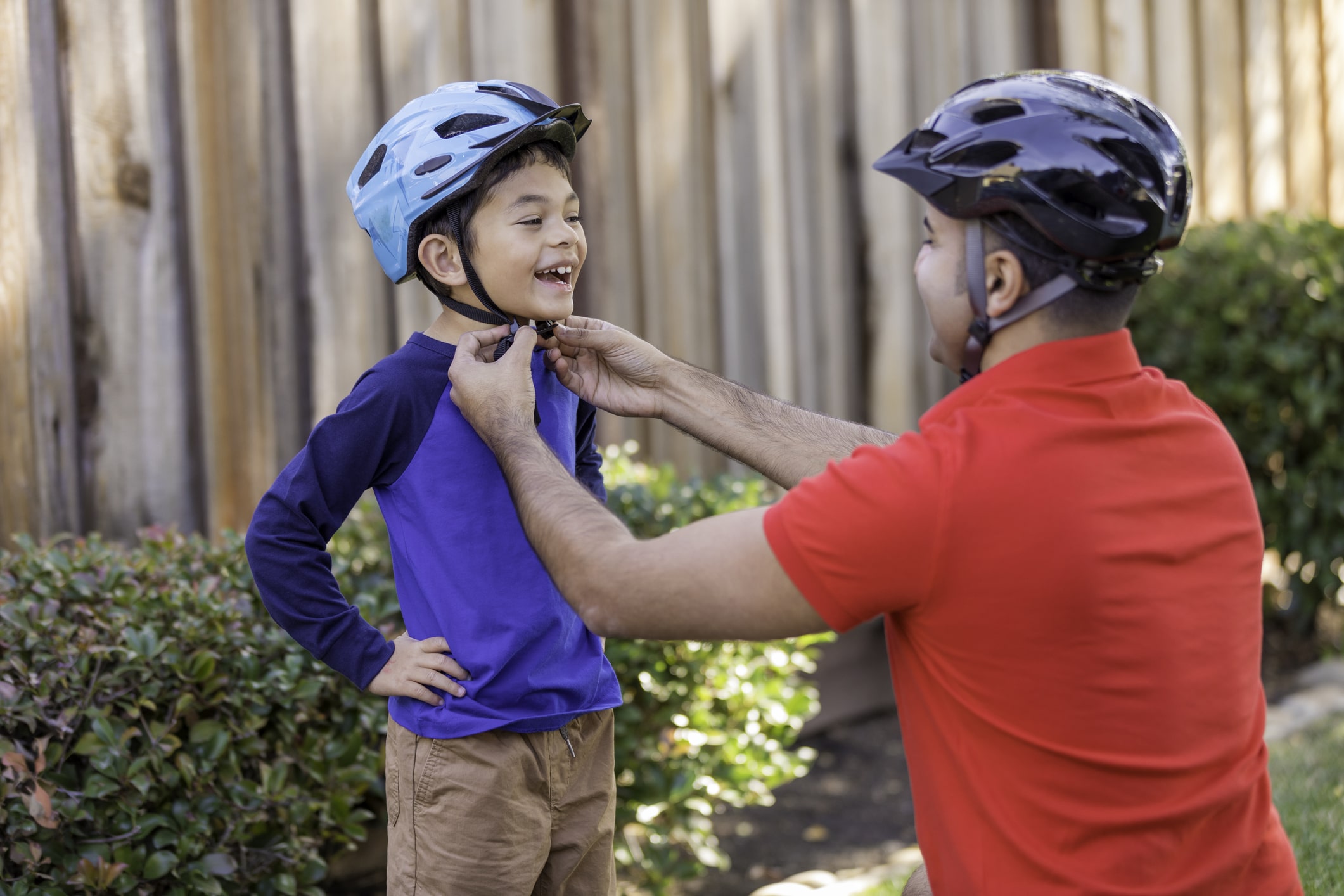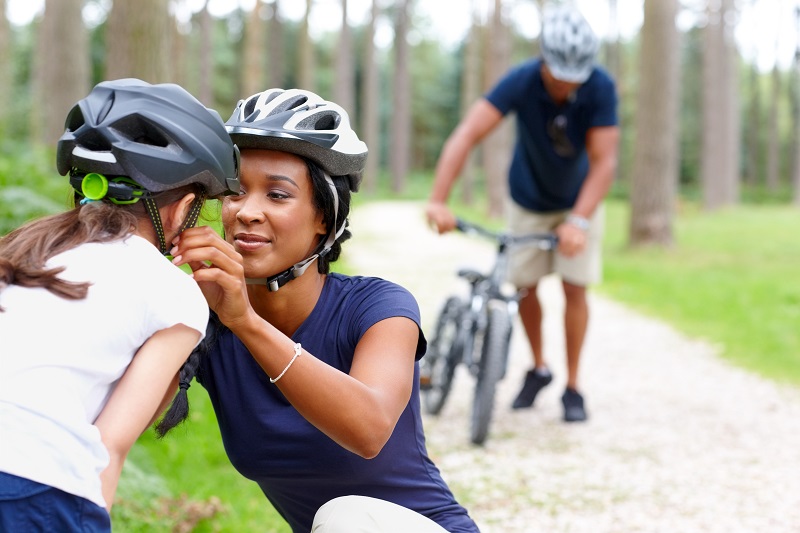In many places, wearing a bicycle helmet is mandatory by law. Helmet laws vary depending on the region and age group.
Bicycle helmets are crucial for safety. They protect the head from severe injuries during accidents. Many countries have implemented laws requiring cyclists to wear helmets, especially for children. These laws aim to reduce the risk of head trauma and fatalities.
Even in regions without mandatory helmet laws, wearing one is highly recommended. Helmets can significantly decrease the severity of injuries. Cyclists should choose helmets that meet safety standards for optimal protection. Wearing a helmet is a simple yet effective way to enhance cycling safety. It demonstrates responsibility and care for personal well-being. Always prioritize safety by wearing a helmet while cycling.

Credit: uoflhealth.org
Importance Of Bicycle Helmets
Bicycle helmets are essential for every rider. They provide crucial protection. Wearing a helmet can save your life. It is not just a piece of gear; it’s a lifesaver.
Safety Statistics
Safety statistics show the importance of helmets. According to the National Highway Traffic Safety Administration (NHTSA), helmets reduce head injury risk by 85%. This statistic highlights the importance of wearing a helmet.
A study by the Insurance Institute for Highway Safety (IIHS) found that 60% of bicycle deaths involved riders without helmets. These numbers prove helmets can make a big difference.
Protecting Your Head
A helmet protects your head during a fall. It absorbs impact and reduces injury risk. Here are the key benefits:
- Reduces severe head injuries: Helmets prevent serious brain damage.
- Prevents skull fractures: Helmets provide a hard shell to protect your skull.
- Minimizes face injuries: Some helmets cover parts of your face.
Wearing a helmet is simple but very effective. It could save your life in a crash. Your head is important. Protect it with a helmet every time you ride.
| Reason | Benefit |
|---|---|
| Reduces Head Injury Risk | 85% reduction |
| Prevents Severe Injuries | Minimizes brain damage |
| Protects Skull | Prevents fractures |
Always wear your helmet. It is the easiest way to stay safe.

Credit: www.hackensackmeridianhealth.org
Legal Requirements
Understanding the legal requirements for wearing a bicycle helmet is crucial. Each region has its own laws, penalties, and regulations. This section will help you stay informed and safe.
Laws By Region
Helmet laws vary widely depending on where you live. Below is a table showing different regions and their requirements:
| Region | Helmet Requirement |
|---|---|
| United States | Varies by state; often required for children |
| Canada | Mandatory in most provinces |
| Australia | Mandatory for all ages |
| United Kingdom | Not legally required but highly recommended |
Penalties For Non-compliance
Not wearing a helmet can lead to penalties. These can include fines or even more severe consequences. Below is a list of potential penalties:
- Fines: Many regions impose fines for not wearing a helmet.
- Points on License: Some areas may add points to your driving record.
- Confiscation of Bicycle: In rare cases, your bike may be confiscated.
Understanding these penalties can help you make informed decisions. Always wear a helmet to avoid these consequences.
Choosing The Right Helmet
Choosing the right helmet is crucial for safety while cycling. A good helmet protects your head in accidents. It also makes riding more comfortable and enjoyable. There are several factors to consider. These include helmet types, proper sizing, and a good fit.
Helmet Types
There are various types of helmets designed for different riding styles. Here are the most common types:
- Road Helmets: Light and aerodynamic, ideal for road cycling.
- Mountain Helmets: Sturdy with visors, perfect for off-road adventures.
- Commuter Helmets: Comfortable and stylish, great for daily rides.
- Kids’ Helmets: Smaller and colorful, made for young riders.
Sizing And Fit
A helmet must fit properly to offer protection. Here’s how to ensure the right size and fit:
- Measure your head circumference with a tape measure.
- Compare your measurement with the helmet size chart.
- Try the helmet on and adjust the straps.
- Ensure it sits level on your head and doesn’t tilt.
- Shake your head gently; the helmet should stay snug.
Remember, a well-fitting helmet should feel comfortable. It should not move much when you shake your head. Always check the fit before every ride.
Proper Helmet Usage
Wearing a bicycle helmet can save your life. But, proper helmet usage is key to ensuring safety. Let’s dive into the essentials of wearing and maintaining your helmet.
Wearing It Correctly
Your helmet must fit well. It should sit level on your head.
- Straps: Adjust the straps so they form a “V” under your ears.
- Buckle: Fasten the buckle snugly. It should not choke you.
- Fit: The helmet should not move when you shake your head.
Check the fit every time you wear it. This ensures your safety.
Maintenance Tips
Regular maintenance keeps your helmet in good condition. Follow these tips:
- Inspect regularly: Look for cracks or wear. Replace if damaged.
- Clean gently: Use mild soap and water. Avoid harsh chemicals.
- Store properly: Keep it in a cool, dry place. Avoid direct sunlight.
Maintaining your helmet extends its life. It ensures it performs well during falls.
Common Myths Debunked
Many people believe wearing a bicycle helmet is unnecessary. This section will tackle common myths and clarify misunderstandings.
Helmets And Vision
Some think helmets block their vision. This is not true. Helmets are designed to be safe and comfortable. They do not cover your eyes or face. Modern helmets have adjustable straps. This ensures they fit well without blocking your view. Here’s a quick comparison:
| Myth | Reality |
|---|---|
| Helmets block vision | Helmets are designed to not obstruct your view |
| Helmets are uncomfortable | Modern helmets have adjustable straps for comfort |
Comfort Concerns
Another myth is that helmets are uncomfortable. Modern helmets are lightweight and well-ventilated. They have padding that makes them comfortable to wear. Let’s look at some features:
- Lightweight materials
- Ventilation holes for airflow
- Soft padding inside
Wearing a helmet does not cause discomfort. In fact, it can be very comfortable. Many riders forget they are even wearing one. Remember, safety should always come first. Wearing a helmet can save your life.
Additional Safety Gear
Wearing a bicycle helmet is crucial, but it’s not the only gear you need. Additional safety gear can further protect you on the road. Here are some key items to consider:
Reflective Clothing
Reflective clothing makes you visible to drivers, especially in low light. It’s essential for night riding and early morning rides. Bright colors and reflective strips on jackets, vests, and pants help drivers see you.
Lights And Signals
Bike lights and signals are vital for riding in the dark. Front and rear lights ensure you’re seen from both directions. Hand signals or electronic indicators let drivers know your intentions.
| Item | Purpose | Recommendation |
|---|---|---|
| Front Light | Visibility | LED with at least 500 lumens |
| Rear Light | Visibility | Red LED with flashing mode |
| Reflective Vest | Visibility | High-visibility with reflective strips |
| Turn Signals | Communication | Electronic or hand signals |
Accident Scenarios
Biking can be risky. Wearing a helmet can save your life. In this section, we will explore different accident scenarios.
Urban Cycling
City streets are busy. Cars, buses, and pedestrians fill the roads. An accident can happen any time. Bikers often face these risks:
- Car Doors Opening: Drivers may open doors without looking.
- Red Light Runners: Some vehicles run red lights, causing crashes.
- Potholes: Hitting a pothole can throw you off your bike.
Wearing a helmet protects your head in these situations. It can reduce injury in urban cycling.
Off-road Adventures
Off-road biking offers a thrilling experience. Trails, rocks, and uneven paths are common. Here are some accident scenarios you might face:
- Falling on Rocks: A fall can lead to head injuries.
- Tree Branches: Low branches can hit your head as you ride.
- Loose Gravel: Losing control on loose gravel can cause a crash.
Helmets are crucial for off-road biking. They can protect your head from serious injuries. Always wear a helmet for safety in these adventures.
Encouraging Helmet Use
Wearing a bicycle helmet is crucial for safety. Encouraging helmet use can significantly reduce head injuries. This section provides strategies to promote helmet use.
For Children
Children are more vulnerable to head injuries. Educating kids on helmet safety is essential. Here are some ways to encourage children to wear helmets:
- Set a Good Example: Parents should always wear helmets.
- Fun Helmets: Choose helmets with fun designs.
- Educate Early: Teach the importance of helmets from a young age.
- Reward System: Give small rewards for wearing helmets.
These steps can make helmet-wearing a habit for kids.
Community Programs
Community programs can greatly influence helmet use. Here are some effective strategies:
| Program Type | Description |
|---|---|
| Helmet Drives | Distribute free or discounted helmets to families. |
| Safety Workshops | Conduct workshops on bicycle safety and helmet use. |
| School Programs | Implement helmet safety programs in schools. |
| Community Rides | Organize community bike rides emphasizing helmet use. |
These programs create a culture of safety and responsibility.

Credit: www.1888goodwin.com
Frequently Asked Questions
Is It Mandatory To Wear A Bicycle Helmet?
In many regions, wearing a bicycle helmet is mandatory. Laws vary by country and state. Always check local regulations.
What Are The Benefits Of Wearing A Bicycle Helmet?
Wearing a bicycle helmet reduces the risk of head injuries. It provides protection and can save lives. Helmets also increase visibility.
Do Helmets Prevent All Cycling Injuries?
Helmets significantly reduce head injuries but don’t prevent all injuries. They protect the head but not other body parts. Always ride safely.
At What Age Should Children Wear Bicycle Helmets?
Children should wear bicycle helmets from a young age. Most laws require helmets for children under 18. Safety starts early.
Conclusion
Wearing a bicycle helmet can greatly reduce the risk of head injuries. It is a simple yet effective safety measure. Prioritize your safety and make helmet use a habit. Remember, a helmet can save your life. Stay safe, stay smart, and enjoy your rides responsibly.

